
A new home of fine tea: Bihar
In the foothills of the Himalayas, the Doke Tea garden is producing fine teas that are winning global awards and rivalling traditional giants
 Image: Anuradha Sharma
Image: Anuradha Sharma
The monsoons have just arrived, and Pothia is already a veritable wonderland. Clusters of jackfruit hang from trees, ready to ripen. Succulent gourds dangle from meshes of wiry branches. Green pineapples glisten, awaiting the yellow of maturity. Jute plants are a mutinous green. The last of the ripened corn fields are ready to be harvested. And nimble fingers work on manicured patches of tea bushes with practised ease. The Dauk river (also called Dahuk and Doke) meanders unhurriedly, adding to the languid beauty of Bihar’s Kishanganj district on the state’s northeast edge, bordered by West Bengal on the east and Nepal on the north.
Pothia comes after a drive of an hour-and-a-half (about 80 km) southwards from Bagdogra airport. A narrow, bumpy road veering off just before Islampur leads us through the lush Pothia landscape to Doke Tea garden.
This garden by the river has created quite a ripple in the tea cup with its handmade specialty teas. If its white tea, Doke Silver Needle, bagged gold at Japan’s World O-CHA (Tea) Festival in 2016, its black tea, Doke Black Fusion, won gold at the UK’s Great Taste Awards (dubbed the Oscars of the food world) in 2015. This April, Doke Black Fusion also won a silver at the Australian Tea Expo’s Golden Leaf Awards.
Doke Tea is owned and managed by the Lochan family of Siliguri, in the Himalayan foothills of West Bengal. The family-run Lochan Tea Limited has been a tea trading and exporting company for 25 years, and is involved in blending and packaging all kinds of teas found in the subcontinent, including Darjeeling, Nepal, Assam, Nilgiri and China. Rajiv Lochan, 63, the CEO and founder, is joined in this business by his wife Manisha, son Vivek and daughter Neha as directors.
On this early monsoon day, I join the Lochans and their Labrador Brownie in one of their bi-weekly garden visits. Rajiv chooses to stay back in Siliguri and prepare for his upcoming trip to China and the US, where he is set to participate at the World Tea Expo in Las Vegas and give a talk on tea diplomacy. “Our teas as specialty teas have generated considerable interest abroad, where we are in talks with a few American companies for further marketing,” he says.
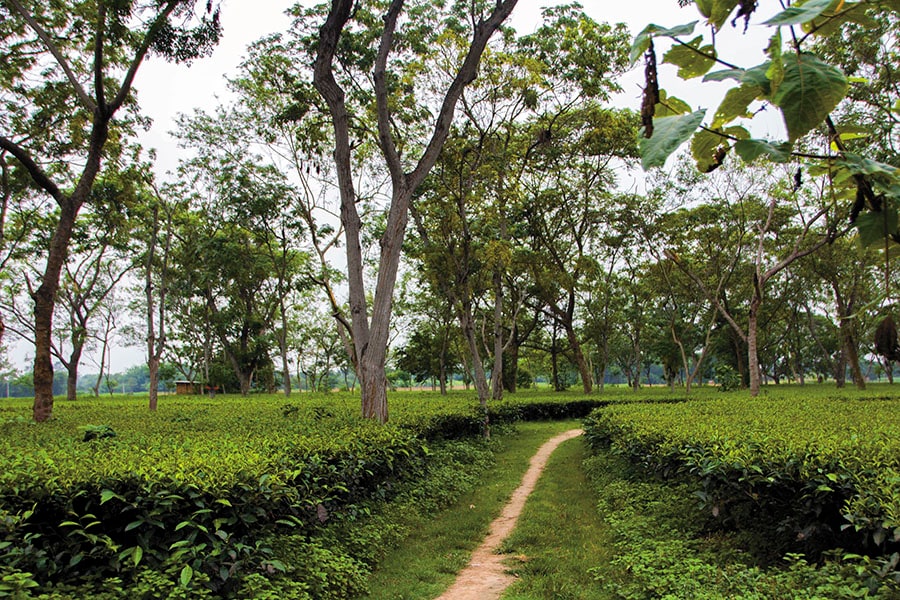
Image: Anuradha Sharma
Two Leaves and a Bud
“Just two leaves and a bud,” says Neha, as we tour part of the 32-acre garden, with eight more acres under afforestation and cultivation of spices and herbs. “You pluck two leaves and a bud for green, oolong and black [orthodox] teas, and just the bud for white tea. Anything more than these goes to the factory to be made into black CTC [crush, tear, curl].”
Neha, who demonstrates the technique of leaf-plucking to us, not only looks after the day-to-day running of the garden, but also crafts the handmade specialty teas herself with generous help from her assistant Bimala Rai, a member of the office staff and a factotum, and other family members.
Along with me are some students from Le Lycee Nicolas Brémontier and Paris School of Business (both in France) who are interning at Lochan Tea Limited. They are learning the ropes of international business by studying the journey of tea from the farm to foreign markets. “Every year, since 2004, we have been having, on an average, five interns for three months. We provide them free housing and food,” says Rajiv.
Our entourage, led by Brownie, winds through well-tended tea bushes, lemongrass fields, spice and herb gardens, poplar and bay leaf plantations. “We grow our own spices, herbs and also flowers that are needed for our blends, such as masala and flavoured teas,” says Neha.
As we descend in front of the manager’s hut, we find the courtyard to be a flurry of activity. The manager’s hut is not the colonial ‘manager’s bungalow’ one might associate with tea plantations. Doke Tea’s office, which doubles as the ‘manager’s bungalow’, is a small two-room clay-and-bamboo structure that also houses a kitchen. “We have used only locally available and natural materials to build the office, in keeping with the landscape, the look and feel of this place,” says Vivek.
One by one, the tea pluckers trudge in with their day’s harvest balanced on their heads. The leaves and buds are weighed, and spread out on the clay floor of the shed by the river. As they lie waiting for the Dauk winds to blow over them, the coal-fed kiln is prepared. There is no electricity supply yet at the garden. “We are planning to get solar power, instead of grid power,” says Neha. “We want this project to be green and ecologically sustainable.”
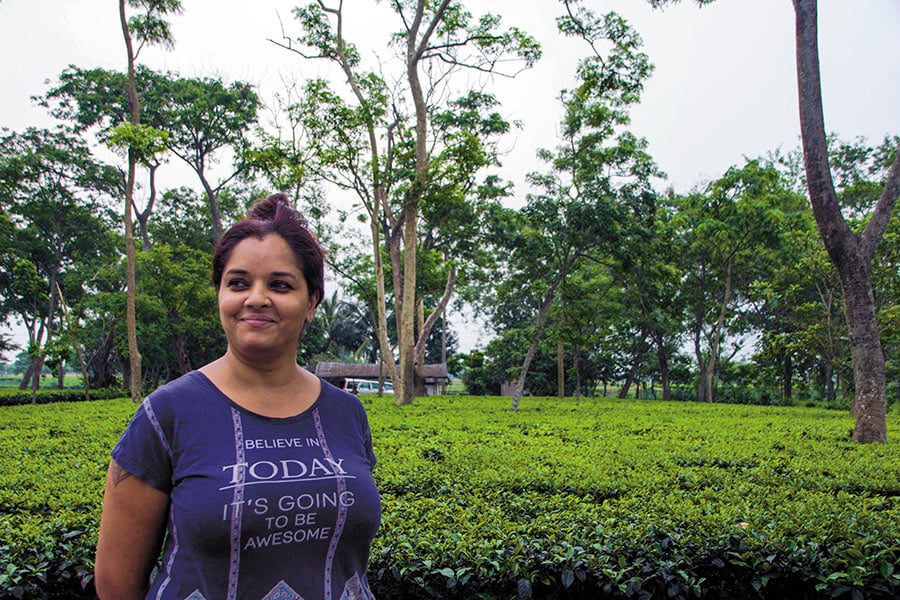
Image: Anuradha Sharma
The fire is lit. As the smoke subsides and the black coals glow orange, the woks—24 inches wide, and made of cast iron—are mounted to heat up. As we wait for the pans to acquire the right temperature, Manisha brings in a plate full of diced raw mangoes, just plucked from one of the trees by the river. With our teeth working on the sour drupes, we watch Neha slowly dry-fry the leaves to make green tea, Doke’s Green Diamond.
With both hands protected in heat-resistant gloves, she scoops up the leaves in the wok and gently turns them every once in a while. “Green tea does not undergo oxidation,” she says. “The idea is to fry them gently, and let the juices run so that the leaves become supple and can be rolled without breaking. This is called the kill-green step, wherein we halt the oxidation process by denaturing the enzymes,” she explains.
White tea does not need oxidising either. “For the Doke Silver Needle, the finest buds that are carefully plucked are sun-dried; that’s all,” says Neha. “The leaf hair turns silvery on drying, hence the name.” This year, a very small quantity of white tea could be made because of unfavourable climate during the first flush, she says. But such is white tea: No matter how much you would like to, you cannot increase its production on a whim. “White tea is very exclusive. It needs the finest buds, which you get only in spring, in the first flush. At the same time, the weather has to be just right too. Too much sun and the leaves are destroyed.”
Black and oolong teas undergo oxidation. The leaves are bruised in such a way that the cell membranes break and the enzymes cause natural oxidation reactions. While oolongs are partially oxidised, black teas are completely oxidised.
After almost an hour of dry-frying, Bimala rolls the leaves and sets them out to dry.
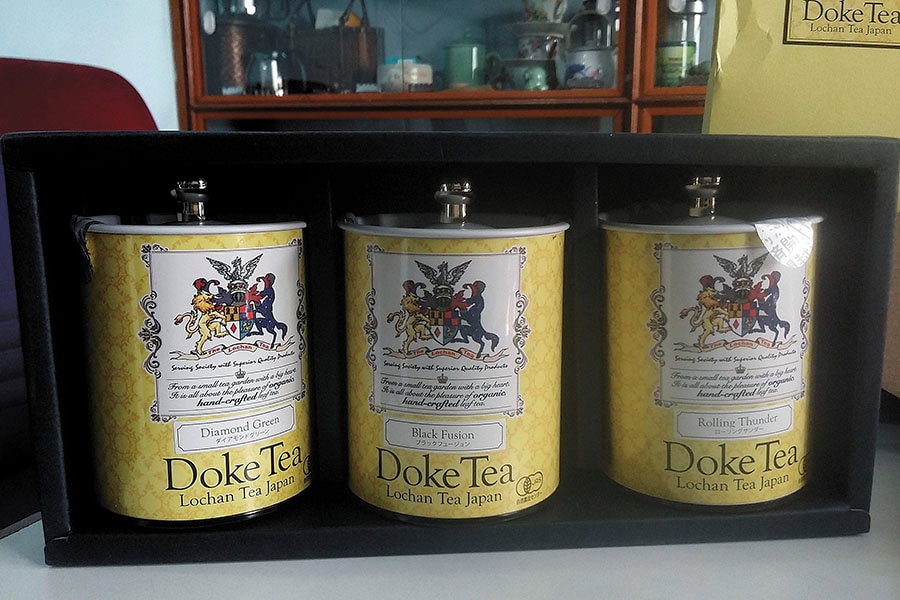
Image: Anuradha Sharma
A Happy Accident
Initially, the Lochans were happy selling tea leaves to factories to be made into CTC teas. Growing tea in Bihar in itself was such a feat that they had not imagined that anything more than the black CTC would be possible from the TB 22 Assam clones. Says Rajiv, “Twenty years ago, when we first thought of growing tea in Bihar, on a land that was completely barren and neglected, it only raised eyebrows. We had to work really hard on the soil; develop irrigation facilities. We planted trees, cultivated grasslands, and tried to create a micro-climate. In a matter of some years, we were able to silence our critics. We actually started producing tea there. We were very happy with that achievement.”
Then the “accident” happened. About five years ago, it so happened that the Doke garden had already sprouted the best tea leaves and buds, but there was still time for the factories to open for the season. One day, Rajiv, as was his habit, was chewing on a bud. What exactly crossed his mind while biting on a Doke first flush bud, he does not remember. But whatever those thoughts were, he got some buds and leaves plucked and packed, and brought them back home to Siliguri.
“There was something in the leaf, some kind of a promise, but I didn’t know what to do with it. I put them in the refrigerator and went off to sleep. After two days, we laid them out on the floor of the office, and allowed them to wither. Then we hand-rolled them before allowing them to ferment, and dried them with hand driers. We were pleased with the results. We kept improvising until we got the perfect orthodox black tea, which went on to become the award-winning Doke Black Fusion.”
That “something” in the leaf, says Rajiv, must have been the doing of Dauk. “Earlier the river used to be a trickle. Then, some seven or eight years ago, it got fed by waters from the Teesta Irrigation Project. It transformed into a sedate, large river, meandering through the landscape, quietly touching everything with its bounty. I like to think it is the river that gave our Doke leaves a Darjeeling-like flavour.”
It is all “honey, nut and spice”, writes Geoffrey F Norman, a US-based tea writer and blogger, while describing the Doke Black Fusion. In his review of the tea on steepstories.com, he goes on to write: “All the usual palatial suspects were there—honey up front, nutty middle, spice and a tannic tickle on the back—but throughout there was a chocolate malted mouthfeel.”
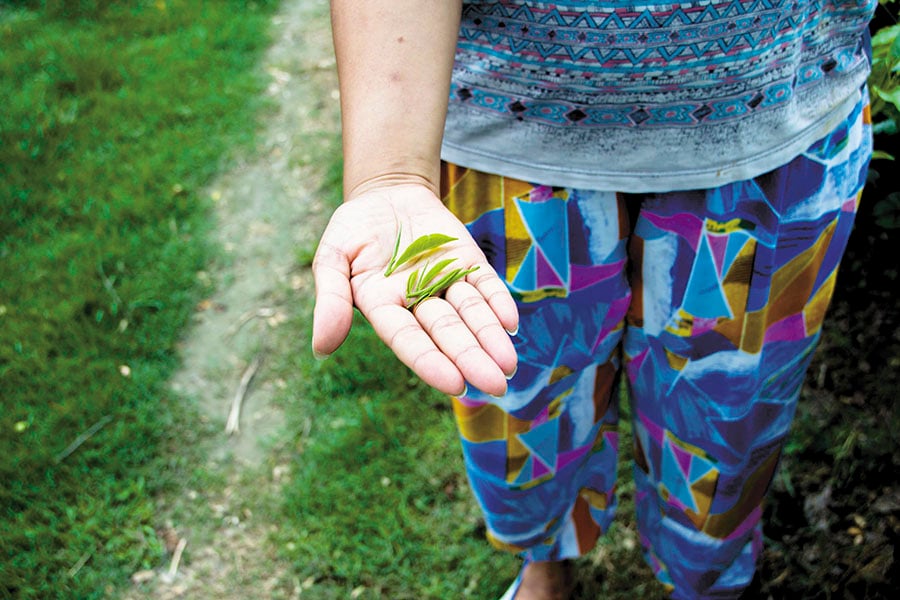
Image: Anuradha Sharma
Norman describes Doke as his favourite tea garden in India and is highly appreciative of its other teas as well. “I’m not the only one to say this, but this is easily one of the best white teas in the world right now,” he says about the Doke Silver Needle. And the Doke Rolling Thunder Oolong “straight-up floored me”.
Currently, Doke produces about 500 kg of handmade black, 200 kg of green and about 25 to 50 kg of white tea. Close to 100 tonnes of tea leaves a year are sold to factories to be made into the traditional CTC teas.
Doke’s handmade specialty teas retail at anything between $60 and $100 per kg, sometimes even more. The Green Diamond prepared by Neha at Doke, Rajiv tells me, fetches him $100 per kg from a Chinese buyer.
“Specialty teas are always expensive and prices average around $100 per kg, compared to $10 per kg for regular teas worldwide, with white tea being the most expensive. Not more than one percent of total world production of 4 billion kg annually is white tea,” says Rajiv.
“Most of our black and green teas are sold in the US, EU and Australia, while our white teas are sold entirely in Japan,” he adds. “Honestly, these are not really big quantities to even call a ‘market’, compared to our business in other teas. What makes us proud is not the quantity, but the fact that we could successfully innovate in a small garden in rural Bihar with such limited resources. Not just that, our innovation has gained appreciation worldwide, won awards by defeating teas coming from places that have been growing teas for centuries.”
Babette Donaldson, the US-based founder of the International Tea Sippers Society and the author of The Everything Healthy Tea Book is all praise for Doke. “I have been drinking Doke tea since its first production, and have watched it mature from a good tea to a very fine, award-winning tea,” she says over email. “The Lochan family’s attention to the health of their plants and the precision of production is what elevates their teas to competitive international standards. Having been a judge in several competitions, I should say that there are usually hundreds of entries, and judges are prevented from any recognition of the origin or producer. Teas are examined by dry leaf, wet leaf and the quality of the liquor. It is where the ‘art’ of producing fine teas is best seen. To be a finalist or winner in these situations is an achievement.”
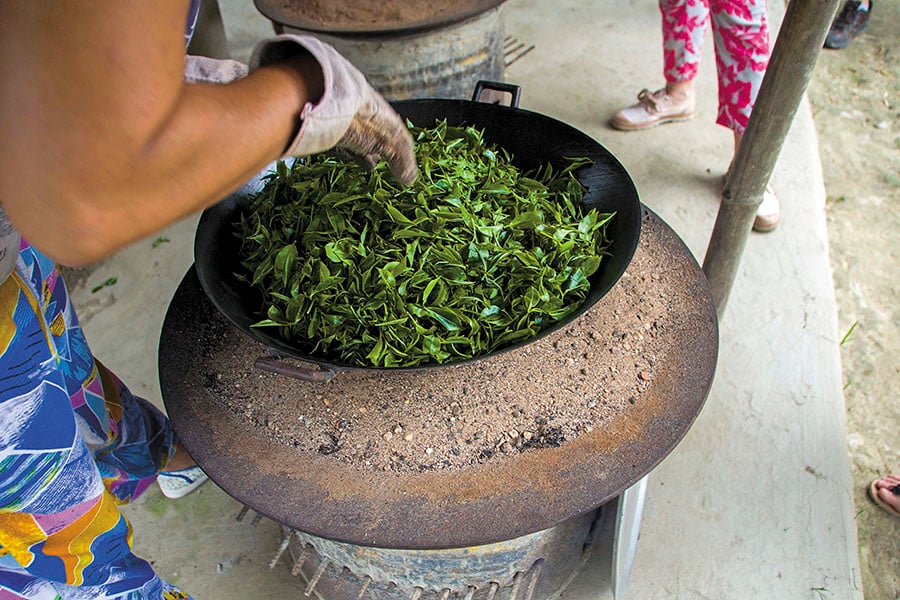
Image: Anuradha Sharma
The Pioneers
The person who brought tea to Bihar is Raj Karan Daftari, originally a cloth merchant based in Kishanganj. A chance stay at a tea garden in Assam made him wonder why tea was never cultivated in Bihar, even in the Terai region—the area south of the outer Himalayan foothills—that is contiguous to, and enjoys similar weather conditions as, West Bengal, which has huge areas under tea plantation.
Much to the consternation of his father and ridicule of peers, he decided to take the chance. He set up the Daftari tea garden, also in Pothia, in 1992. “It was crazy. Since I had no prior experience in tea, I had to learn everything from scratch,” says Daftari, 58, the managing director of Daftari Tea Estate Pvt Ltd. “Some things would work, some didn’t. It was a struggle and a lot of money also went to waste initially.”
But the gamble paid off. Daftari’s teas, which sell under the brand name Rajbari, have acquired quite a name for themselves. “We have a market spread across India. We are the sole tea suppliers to the Central Police Canteen,” says Daftari. Today, the Daftaris run a tea garden and a tea factory as well, with several of their extended family members involved in tea-growing.
Daftari’s success spawned an industry in Bihar. Apart from encouraging his extended family members, friends and business peers to take up tea cultivation, he also invited investors and growers from other states to do business in Bihar, with the help of the state government.
The Lochans are one of the families that were attracted by Daftari’s success. But they are the only ones making handmade specialty teas from their garden, while others are content with the traditional CTC—the most commonly consumed tea in India, boiled with milk and sugar.
Clusters of small gardens have mushroomed in Bihar over the years. “Today, there about 20,000 acres of land under tea cultivation,” says Daftari, who is president of the tea planters’ association in the state. It’s difficult to ascertain exactly how many gardens there are, says Daftari. “It is still quite unorganised, and there are no clear numbers. Even small farmers with one, two or three acres have taken up tea farming.”
Currently, there are eight factories processing green leaves. “Together they produce 10,000 tonnes in a year,” says Daftari’s son Manish, who is also part of the family-owned business. “Doing a bit of back calculation, it can be assumed that the volume of raw tea leaf produced in Bihar is about 45,000 tonnes.”
It must be noted that unlike the traditional plantation model— which are very large, integrated businesses that combine tea growing with manufacturing— Bihar’s is the ‘independent’ model. Here, the growers are small land holders. They only grow tea and sell the raw leaves to stand-alone factories, which are called ‘bought-leaf factories’. This model is increasingly gaining popularity in India and abroad, for enabling low production costs. They also do not have to bear high social costs associated with plantation gardens, making labour more affordable.
Manish is happy with Doke’s experimentations and international success. “Their efforts are worth appreciating,” he says. “When you look at the tea-drinking world outside, you realise how little of these kinds of innovations we do in India.”
But the Daftaris are not entirely new to innovation themselves either. “We do various tea mixes, such as the iced tea mix. For a small place like ours, these are significant innovations.”
A New Crop of People
“They are all new tea-people,” Manisha says, introducing the three full-time, local staff at Doke. “The emergence of gardens has brought many new people, and not just the owners, into tea here.”
Doke’s manager Rafael Chore is still called Masterji—he had once taught at a school. It is at Doke that he got to savour his first green tea. “The only tea I knew was chai,” he says. “On joining here about six years ago, I got to know that teas could be green, white, and oolong.” Supervisor Munshiji Abdul Towaf, who earlier worked in a brick kiln, says he likes being in the tea business for a “different kick”. So does Pawan Paswan, the second supervisor, who helped set up Doke from scratch by doing odd jobs as a labourer.
Meanwhile, our lunch is polished off in what seems like a picnic by the river. The mango tree is emptied of its last fruit. Green coconuts are picked. More than 50 kg of raw leaf are packed to be taken to Siliguri. They will be made into black tea.
The ripples on the Dauk have turned orange; evening is setting in on Doke. It’s time for the workers to go home in a colourful train. It is also time for the tea bushes to sleep, to the lullaby of chirping birds finding their way home.
(This story appears in the 30 November, -0001 issue of Forbes India. To visit our Archives, click here.)




